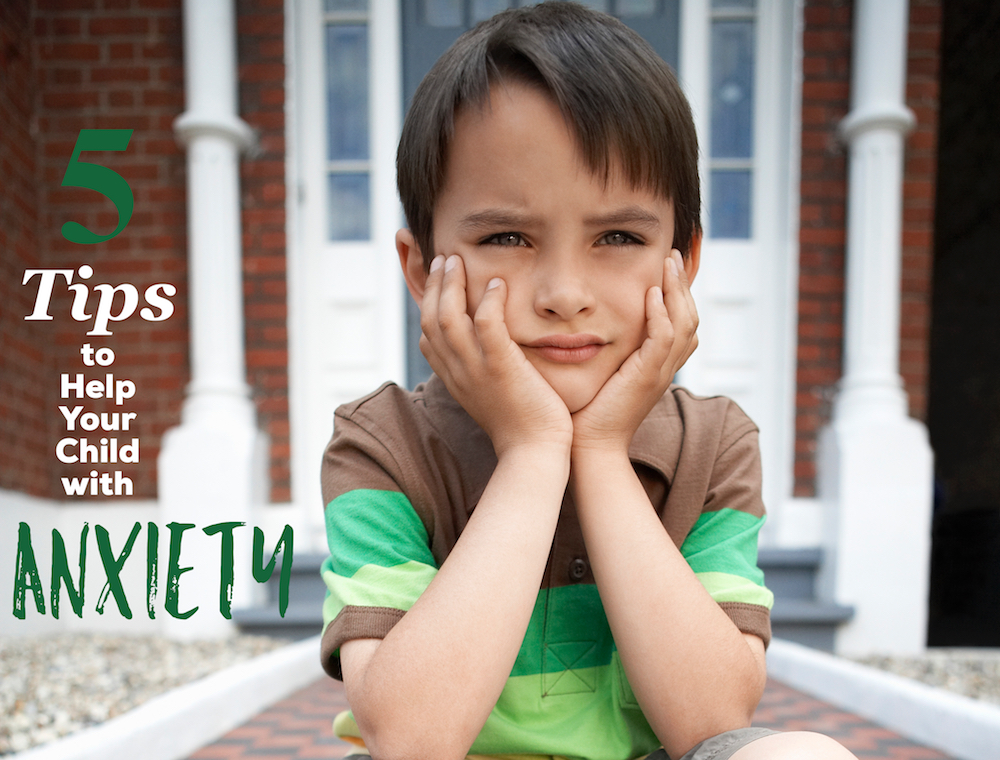
30 May 5 Tips to Help Your Child with Anxiety
Like many adults, children are not always aware when they are suffering from anxiety. They often do not have the maturity or understanding to express why they feel anxious or fearful in situations. This can lead to stressful situations for not only the child but to a parent as well. As an occupational therapist with close to 20 years of experience working one-on-one with children, I have come across many families with this concern. I have offered a variety of suggestions to relieve stress and anxiety in children for numerous scenarios. Here is a list of the five most common tips to help your child with anxiety.
#1 Schedule Relaxation
There are so many options to occupy a child’s time these days. From cake decorating to karate to swimming and everything in between, children often have packed schedules where their every minute is color coded into a chart in 30-minute intervals. Parents are so busy trying to keep their children busy they forget to schedule relaxation. Just like adults, children need time to rest their bodies and brains. They need time to play in unstructured ways as well where teachers or other adults are not influencing their imaginative thoughts. This down time is sometimes just what is needed to reduce anxiety. Imagine how relieved you would feel if you scheduled in 30 minutes a day for yourself to just be.
#2 Maintain Routines
One of the upsides of having a schedule is giving a child a sense of a routine especially if you have a visual example to follow. Routines allow for expectations. Children with anxiety often fear the unknown. They worry about what could happen. Establishing routines helps to reduce the chances of unpleasant and undesired surprises. Routines also give children a chance to prepare mentally for stressful situations. If they know they will have to be in an environment that is not their first choice, it gives them a sense of control to know what’s ahead for them. Routines are also important with maintaining sleep and feeding routines as children age.
#3 Identify the Source
Helping your child with anxiety does not necessarily mean eliminating it. However, helping to identify the source can help to reduce it. This is not as simple as asking a child because they do not often know how to communicate these complicated feelings. I frequently suggest to parents to keep a log of when anxiety attacks or tantrums occur. It is also important to record factors like the time of day, location, proximity to eating, other persons involved, etc. Sometimes a child may sense a pattern and demonstrate signs of anxiety before an event knowing it is approaching. This is where communication is key. This does not mean asking a child directly what is bothering them, but listening to their words and putting pieces of a puzzle together.
#4 Keep Calm
We have all seen variations of the campaign, “Keep Calm and Carry On.” Although you may not be facing a military invasion, you can still take note of this motivational message. Children will react if you are reacting, so if you overreact they will too. I have had my share of experiences where a child’s behavior has frustrated me and forced me to embrace this motto. We have to remember to be examples of how we wish children to behave. Therefore, when a child is demonstrating signs or effects of anxiety, the best practice is to remain calm for them. Teaching children how to take deep breaths is a great way to start these practices in addition to using a low volume and slowed speech when speaking to them.
#5 Practice Mindfulness
Along with teaching children breathing techniques, developing mindfulness practices with children can help tremendously with reducing and managing anxiety. Techniques like yoga and meditation can seem like advanced concepts for children, but simple exercises can be introduced for their age level in engaging and playful ways. Examples of mindfulness practices can include describing the taste and texture of food while eating or body scanning where a child squeezes the muscles of individual body parts and recalls them upon request. Other exercises can include following a sequence of movements that you imitate for them or listening to guided imagery while keeping their eyes closed.
These are just a few of the simple techniques and tips that I suggest to parents to help them with the anxiety experienced by their children. You can see that these suggestions are very similar to what would also be suggested to an adult. The difference is in the delivery. It is important to make sure that a child feels safe and not shamed for their feelings. Acknowledging that the feelings are valid and okay is the first step. Overall children should be introduced to positive habits for the mind and body to promote their health and wellbeing.
Amy Baez, MOT, OTR/L
Amy Baez is the Founder of Playapy and Creator of the PALS Handwriting Program. She is a pediatric occupational therapist, speaker, and parent coach with over 18 years of experience. Learn more at www.playapy.com.
